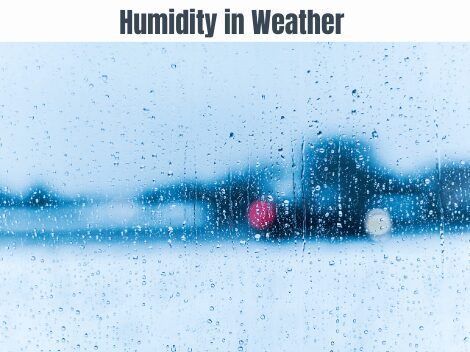
Introduction
Moist air or moisture in the air is generally known as humidity. Moist air or moisture Humidity in weather is mainly air containing water in the form of water vapor. When there is a large amount of water vapor in the air, that air becomes moist air. The water vapor holding capacity of air depends on the temperature of the air. Based on this the air becomes saturated when it holds the maximum amount of vapor at a particular temperature. It is very important to know what is humidity in the weather. As the amount of water vapor in the air or the humidity regulates our physical comfort a lot. Humid air is more uncomfortable and unhealthy for people than dry air. Humidity is water that stays in the air and evaporates. Warm air contains more moisture than cold air (1) & (2).
Definition of Humidity
Water vapor is an important component of air. Water vapor constantly upturned from the earth’s surface and mixed with the atmosphere. Humidity is the element of water vapor present in the air, in gaseous form at particular times and places. The air can be humid, extremely humid, dry, etc. The air that has the highest amount of water vapor is known as moist air. Air that has very little water vapor is called dry air. Humidity is divided into three parts (2).
- Absolute humidity
- Relative humidity
- Specific humidity
Absolute Humidity
The actual measure of water vapor present in a certain volume of air is known as absolute humidity. Absolute humidity is expressed as grams of water vapor per cubic meter of air (3).
Relationship between absolute humidity and temperature
There is a proportional relationship between absolute humidity and temperature. As the temperature rises, the absolute humidity increases, and as the temperature decreases, the absolute humidity decreases. Because, as the temperature rises, the water vapor holding capacity of the air increases. As a result, absolute humidity increases. The opposite happens when the temperature drops. Therefore, absolute humidity increases in summer and decreases in winter (3).
Absolute Humidity is directly proportional to temperature
Relative humidity
The relative humidity is the ratio of the amount of water vapor present in a certain amount of air at a given temperature and the ratio of the amount of water vapor required to saturate the same amount of air at that temperature (3) & (2).
The formula of relative humidity
Relative humidity = (the amount of water vapor present in the air/ the amount of water vapor needed to saturate the air) X 100.
For example
The amount of actual water vapor in 1 cubic cm of air at a temperature of 25°c is 15 gm and the amount of water vapor needed to saturate the air is 22.9 gm. Therefore the relative humidity = (15/22.9) X 100 = 65%
Relationship between relative humidity and temperature
The relative humidity is inversely proportional to temperature. That is as the air temperature rises, the relative humidity decreases and as the air temperature decreases, the relative humidity increases. This is because as the temperature rises, the water vapor capacity of the air increases. As a result, the absolute humidity increases. So the relative humidity decreases. When the temperature drops again, the exact opposite happens (3).
Importance of relative humidity
- It indicates the level of air saturation, the number of different types of precipitation, and their distribution and probability.
- Determines the rate of heat radiation on the surface.
- The relative humidity controls the rate of evaporation from the water and the plants (1).
Specific Humidity
Specific humidity is the ratio of the amount of water vapor in a particular amount of air. This humidity remains constant and is expressed in grams (1).
Example
If the water vapor present in 1000gm or 1kg of air at a particular time of the day weighs 15gm, then the special humidity of that air is 15gm per kg (1).
Humidity measurement
The instrument used to measure humidity is called a hygrometer or dry and wet bulb thermometer. There are two thermometers on both sides of the hygrometer. The thermometer to the left of the hygrometer device is the dry-bulb thermometer. The right-side thermometer is called a wet-bulb thermometer (1).
Effects of humidity on weather and climate
There is a relationship between climate, weather, and humidity. Humidity affects the climate and temperature. There is a direct relationship between humidity with air pressure, clouds, and rain. When the temperature rises the water evaporates and forms water vapor. With the rise in temperature, the air gets warm and therefore its water vapor holding capacity also increases. the density of the water vapor is lighter and thus it rises and condenses when comes in contact with cold air which ultimately forms clouds and rains. Clouds, rain, fog, etc. are the result of condensation of water vapor.
High humidity in the air hence causes rain and clouds on the other hand if the air does not have humidity for a long time then no rain will be there. It results in the formation of deserts. Humidity and rainfall are therefore directly proportional to each other This shows that the climate and weather are particularly affected by the humidity (2) & (3).
